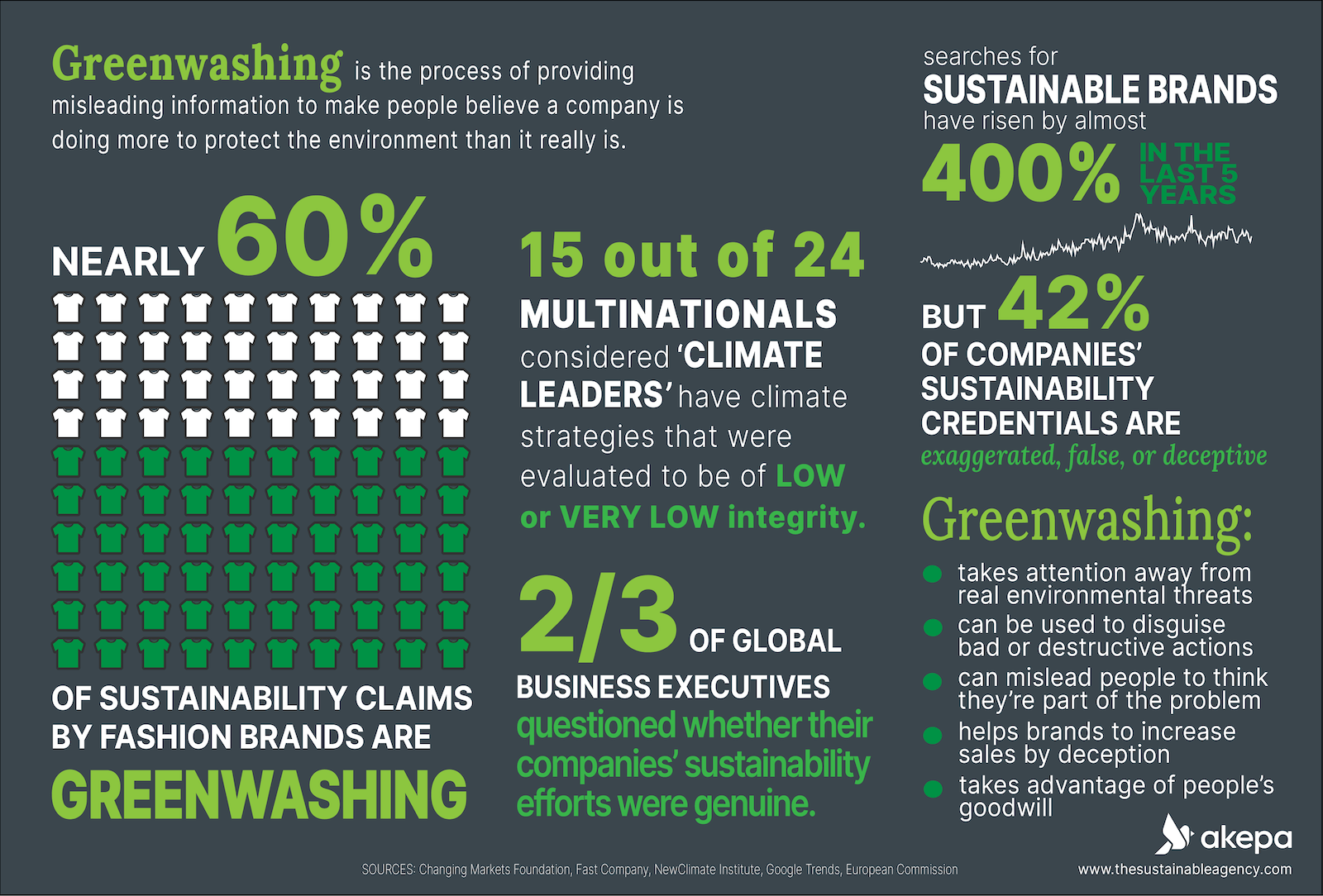Greenwashing isn’t about getting your dishes clean using the least amount of water. Nor is it an innovative way to clean vegetables. No, it’s much more insidious than that.
Greenwashing is when an organisation or brand spends more time and money on marketing themselves as environmentally friendly than on actually being environmentally friendly and minimising their environmental impact.
It’s a performance of sustainability without any of the action of sustainability. At its simplest, greenwashing can be subtle packaging tricks. Think of the battery-farmed eggs with pictures of rolling hills and verdant countryside on the box. It’s not making an outright claim but it is trying to guide us away from the reality of how those eggs were farmed.
On a much larger scale, greenwashing can affect culture in pretty massive and alarming ways. We’re all familiar with the concept of a carbon footprint, right? But how many of us know that the term ‘carbon footprint’ and the concept of carbon footprint calculators were the invention of BP with the help of ad agency Ogilvy? The idea being that it’s individuals that are responsible for heating the world by going to work, travelling and eating food – rather than the responsibility of enormous oil conglomerates who have leaked hundreds of millions of gallons of oil into the Gulf of Mexico.
And yes, clearly it’s a good thing for all of us to be aware of our carbon footprints but having a company like BP be the arbiter of our actions is greenwashing of the highest order.
How to spot greenwashing
There are a few common tricks that you can watch out for to make it easy to spot greenwashing and dubious sustainability claims:
- Vague ‘green-sounding’ language: Look out for words that sound good at first but have no concrete meaning legally. ‘Natural’, ‘eco-friendly’, ‘responsible’, ‘farm-fresh’.
- Irrelevant claims: Making a big noise about one tiny green attribute on an otherwise totally anti-green product. Think of palm oil with a big label about how the bottle is recyclable.
- Badly thought-out big gestures: This is a classic one when an idea has clearly come from a marketing team that hasn’t consulted experts. British supermarket M&S recently got in trouble for this, when they planned to release 30 million honeybees into the countryside. Sounds good on paper, but they quickly had to backtrack when experts pointed out that it would have catastrophic effects on ecosystems.
- Misleading numbers and percentages: This could be a label that reads ‘50% more recycled content than before!’, when in reality that content has risen from 2% to 3%.
- Rebranding to include ‘natural’ packaging: Products that change their look to apply the veneer of sustainability, but without actually changing anything. Coffee beans that suddenly come in brown paper bags; homeware that seduces with its subtle earthy design and messaging.
- Making the product packaging green: yes, this simple ploy has been tried out a few times. A good example being Coca Cola Life.
- No sustainability page: if you’re checking a brand’s website and they don’t have a sustainability page with specific details, then that’s a red flag.
At its core, greenwashing is all about misdirection. Putting a compelling performance in one place to try and distract people from the issues that matter. The sad thing is that it’s usually those who care about the environment who fall for it.
So what should we be looking out for to know if a brand is acting sustainably for real – and actually changing its business practices to improve things?
- Accountability: Ironically, truly sustainable brands are those that are transparent about how they’re affecting the environment. Look for annual reports and stats on websites.
- Accreditation: Don’t just take brands’ words for it. Look for companies that are audited or accredited by third parties – to be awarded things like B Corporation status or Fairtrade certifications. At Akepa we are ClimatePartner certified. Climate Partner being one of the world’s leading climate action companies.
- Clear labelling: Truly sustainable products should include simple language labels about exactly what materials or ingredients are in a product – and how they’re sourced. Claims should always be precise and clear.
- Traceability: Some forward-thinking brands have been helping buyers track their products’ sustainability using helpful tech. As a case in point, sustainable fashion brands are using QR codes for supply chain traceability. If you see this kind of nifty new extra on a product, it’s a good sign.
- Circularity: The best sustainable brands will take measures to improve the recyclability, repairability and durability of their products. Over the past few years many of the most sincere sustainable fashion brands have introduced pre-loved and repair programmes, for example.
If you need help from a sustainable marketing agency in avoiding some of these pitfalls for your brand, get in touch and we’d be more than happy to help you promote your sustainability. After all, when great marketing gets behind an authentically sustainable product, it’s far more powerful than grimy old greenwashing.
P.s – for the mirror image of greenwashing, then take a look at this other post from Akepa on greenhushing.





Leave a Reply